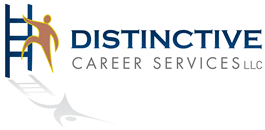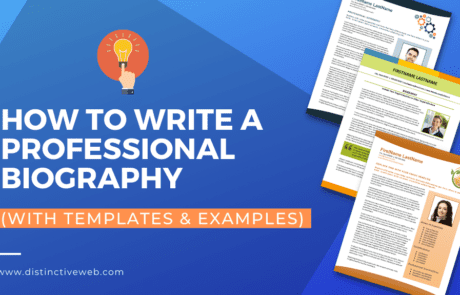
It’s no secret that a compelling, attention-getting resume can be the difference between landing your dream job and crash landing into a sea of comparably dull resumes.
A great resume gives you a significant competitive edge in the job market. Conversely, a bad resume can bring your job search to a stall.
It is true that your job descriptions are just one part of writing the perfect resume. But it is also true that well-constructed, engaging, compelling resume job descriptions are the backbone of a modern resume that stands out from the pack.
How To Structure Your Resume Professional Experience Section
With the exception of entry-level job candidates, most job seekers will have a work history comprised of at least a couple of past employers and sometimes multiple jobs within each employer.
While choosing the right resume format will be an individual process for every job seeker, this format will include an employment history section for most job seekers. In this section, you will list each past job and other relevant professional experiences (such as volunteer work) in reverse chronological order.
At a minimum, each job description in this section will include the company’s name, your job title, and the dates you held the job title. Most job seekers will also include the basic details of the job, such as the job responsibilities and other relevant information, such as technical skills or other key skills.
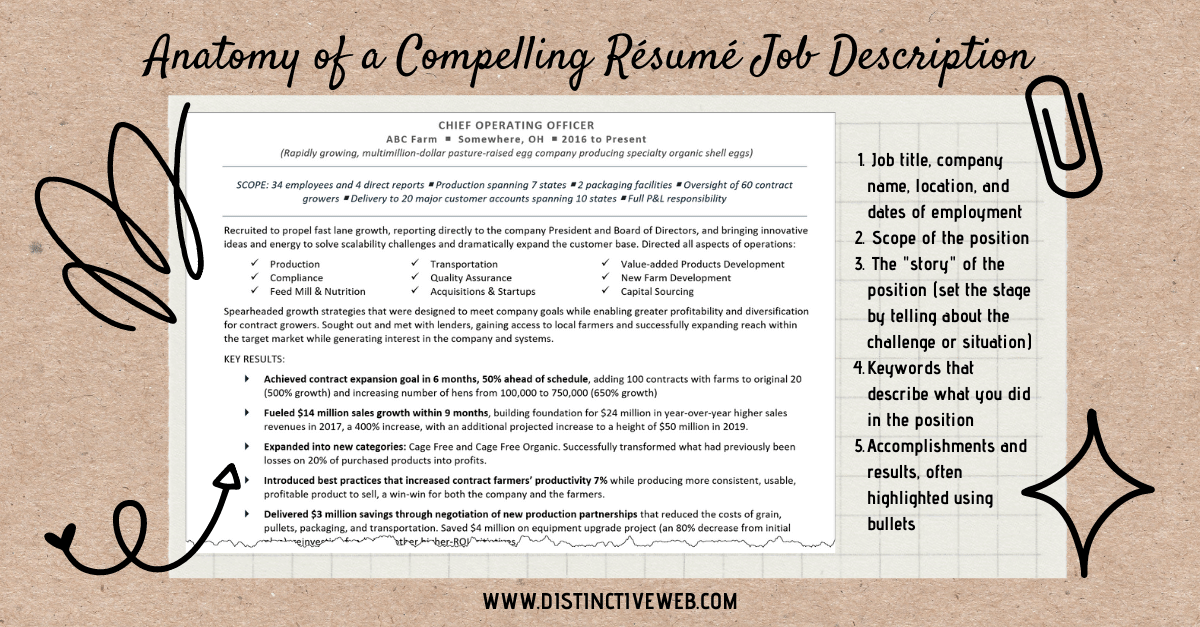
But, to write a really compelling resume job description, the key is to go beyond the typical recitation of job responsibilities.
The Insider Secret to Writing a Compelling Job Description
It is all about storytelling.
Hiring managers don’t care about what you were supposed to do (which is what responsibilities and job duties tell them).
They care about what you did–as in what you accomplished. And more to the point, how your accomplishments benefited your past employers.
When you use a storytelling format to write resume job descriptions, you captivate hiring managers with relevant, memorable content that helps the hiring manager to make connections between your past work history and your future potential.
Here then, are some tips for writing compelling resume job descriptions. Start with the basics and consider the ABC’s of resume writing that will have hiring managers’ heads turning.
A: Allow Verbs (Not Adjectives) to Tell Your Story
Fill each resume job description with verbs. Adjectives can make the text more engaging but should be used sparingly (read: extreme moderation!). Instead, use concrete examples of accomplishments headed by verbs to describe your work history.
Too many descriptive adjectives can obscure and make your job description seem filled with fluff. Verbs, on the other hand, imply action and accomplishments.
Compelling verbs showcase what you have done and highlight ways you’ve turned challenges into successes without the story getting lost in a pile of pretty prose.
You can see how to do this in the following resume job description example. Note the extensive use of verbs (highlighted) in this job description.
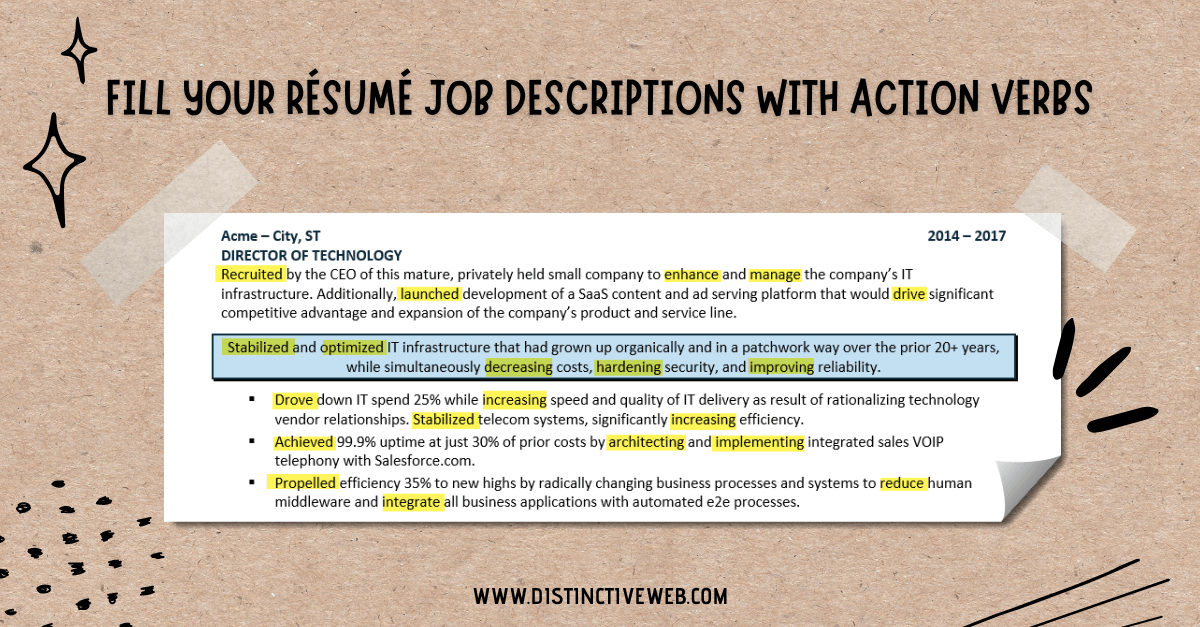
Formatting your resume job description with a few bullet points will also make it easier to read. Try breaking out accomplishments with bullet points. Ideally, between three to five bullet points per job description though a couple more or less is acceptable. Typically, you should include fewer bullet points the further back you go in the chronology of your past jobs.
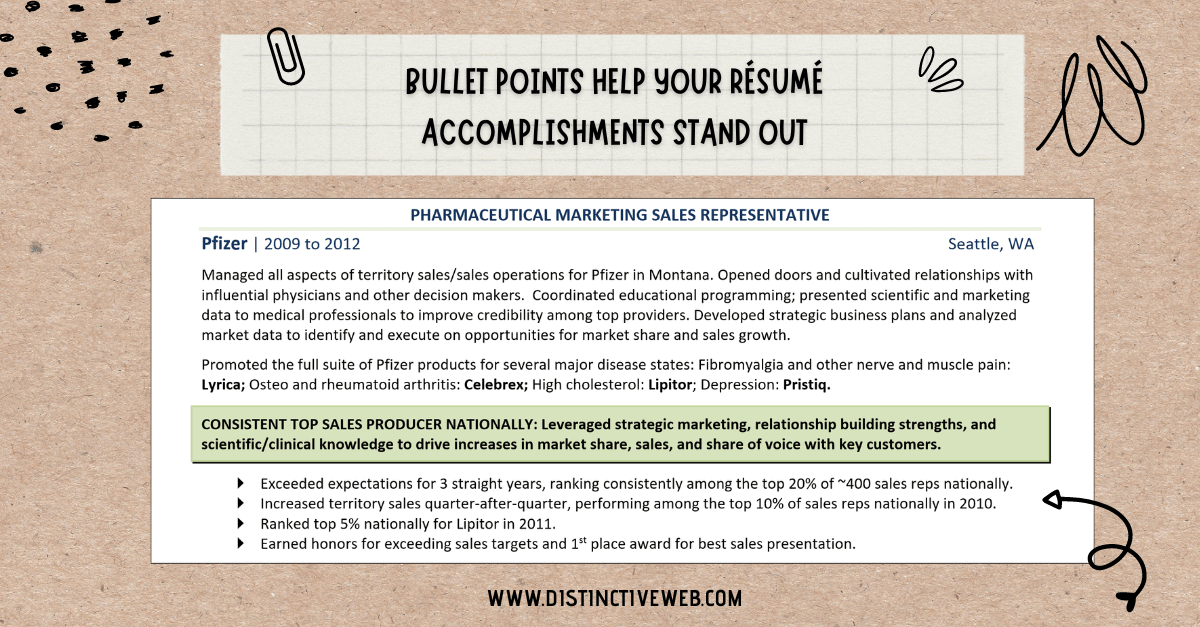
By definition, an accomplishment is something that has already happened. In other words, it happened in the past. This means that each bullet point should begin with a past tense verb. Powerful, active verbs deliver your message with a punch.
Finally, use a thesaurus and diversify your verbs. Repeating the same words can lower effectiveness, making your resume seem flat and redundant rather than persuasive. The following resume job description examples illustrate all of these suggestions in practice.
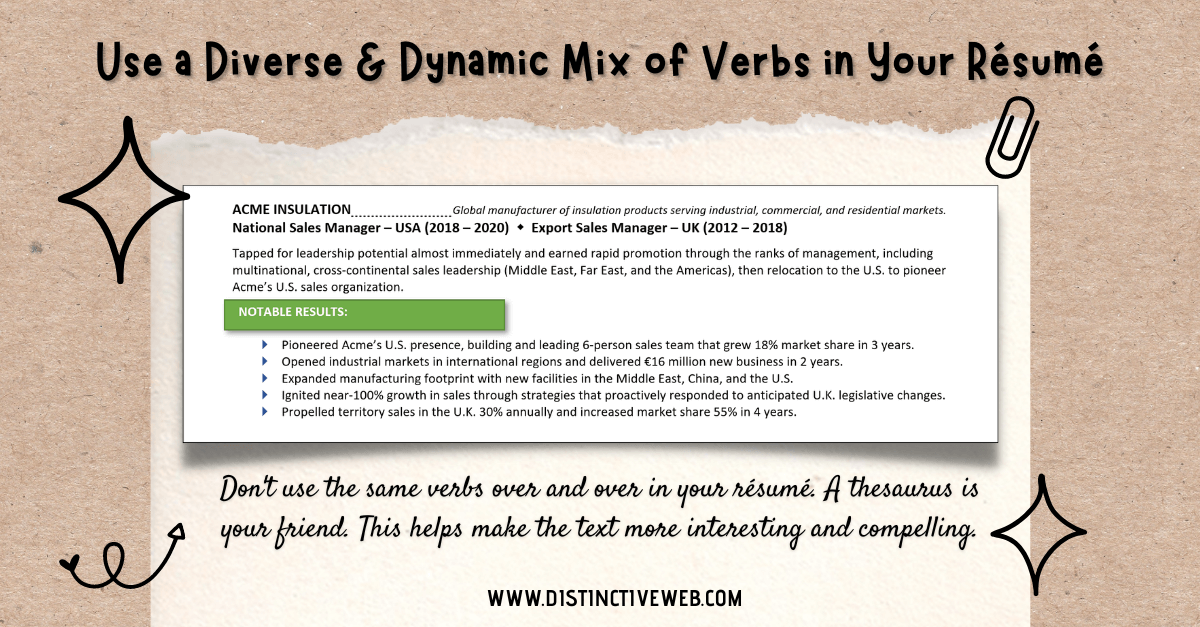
B: Bland is Boring – And That’s Bad
Your goal is to stand out from the crowd. If your resume job description text is more boring than bold, that’s bad – and probably not going to open any doors.
Think about it this way. Advertisers spend millions of dollars annually creating commercials that grab consumers’ attention.
They want to get as much use out of every dollar as possible. That’s why they create jingles. Jingles stick in your head, and ads often include loud voices and bright colors that are hard to ignore.
Similarly, your resume is an advertisement letting companies know that you are their best option – a credible candidate who knows how to deliver value and garner results in challenging situations.
You want the hiring manager to walk away from your resume humming the tune that says, “this is the candidate I’ve been looking for.” Your resume job description is your jingle, as shown in the following job description example.
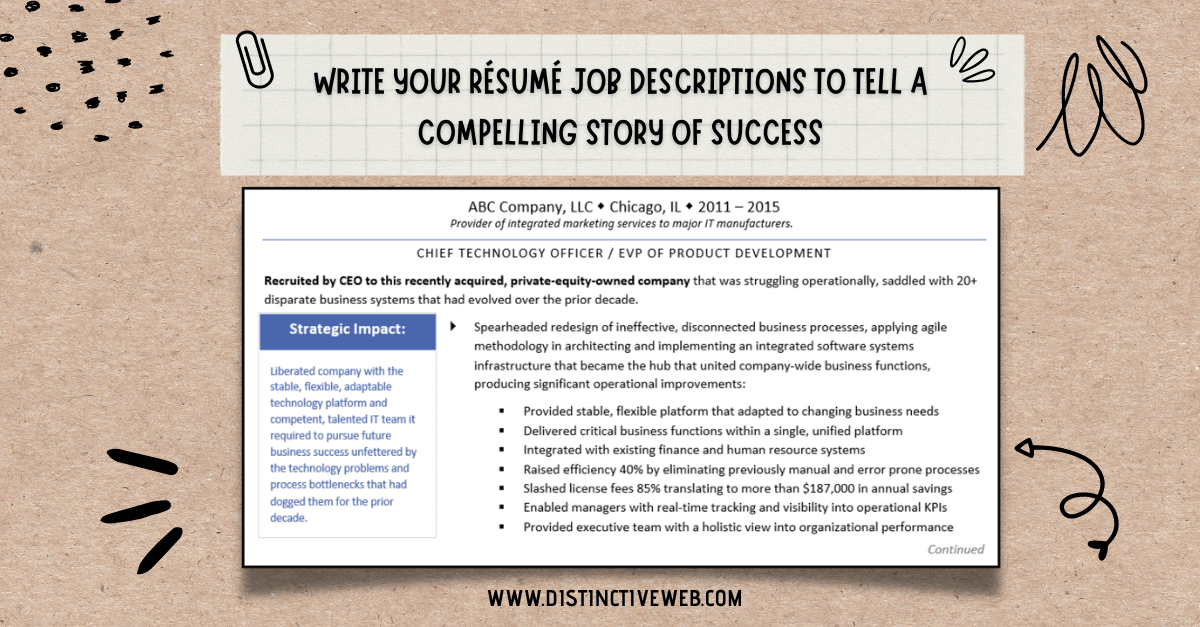
There are three parts to telling a compelling story in the job description section of your resume:
- The challenge or situation: What was the situation in the company when you worked there? What were the significant challenges or problems you dealt with? What were your primary goals?
- The actions you took: What did you do to meet those challenges, solve those problems, or achieve those goals?
- The results: What were the positive results of your actions concerning the challenges or problems? How did your employer benefit?
Reread the sample job descriptions shown throughout this post. Can you identify the three parts? This is called the C.A.R. approach to writing a resume, and it is one of the trade secrets of professional resume writers. Done well, this is a fail-proof way of getting your resume noticed.
C: Connect the Content
Hiring managers typically put real thought into every job posting. When you read a job ad, you will often find a detailed listing of qualifications sought by the hiring manager. As a job seeker, when you submit your job application, it only makes sense that your resume should include some of the same wording used in the job posting.
There are two reasons for filling your resume job description text with the words and phrases that potential employers use in job ads.
The first reason is that these words usually describe key skills–both hard skills and soft skills– that are important resume keywords. Including the most important resume keywords are essential for ensuring your resume performs well in applicant tracking systems (ATS).
The following job description example shows a pro technique for fitting extra keywords into your resume job description section.
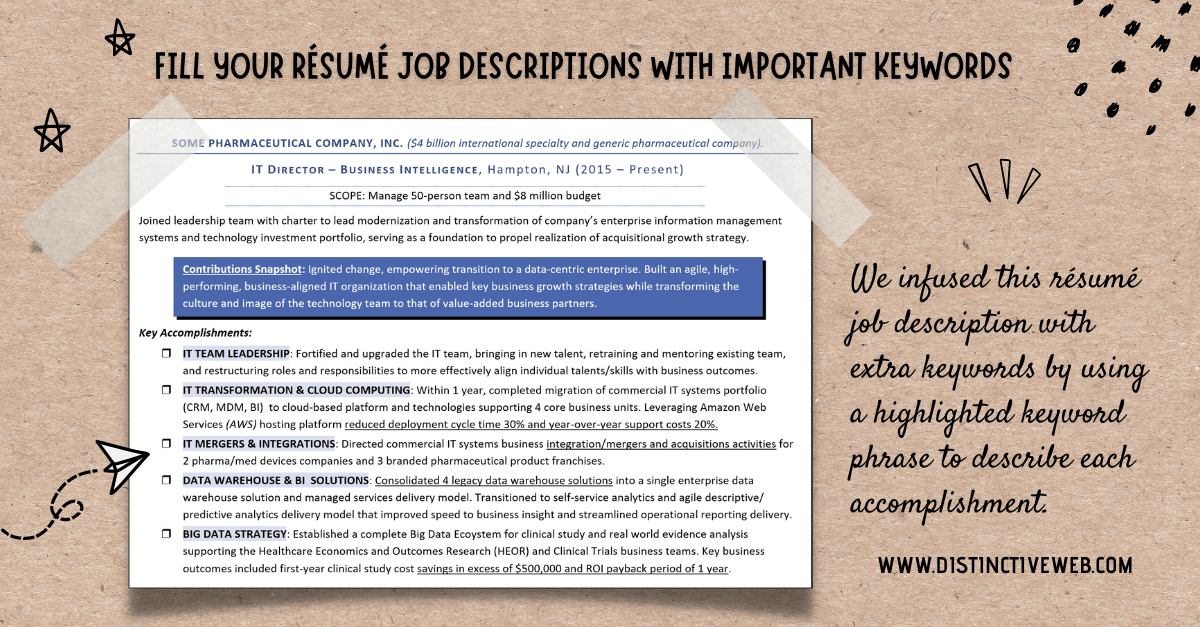
In the following resume job description example, the job posting made it clear that the employer was seeking a strong team leader and coach with the ability to improve the performance of a sales team. The story told in the job seeker’s resume showed how past relevant experiences prove that this job seeker is the perfect hire to meet the employer’s needs.
The second reason for using these keywords is that they help show connections between your relevant experience (shown in your C.A.R. scenarios) and the company’s needs.
For example, if the job posting calls for “agility and resilience,” each resume job description should highlight the instances in your employment history demonstrating those characteristics. Make the connection between your compelling content and the position you want to fill.
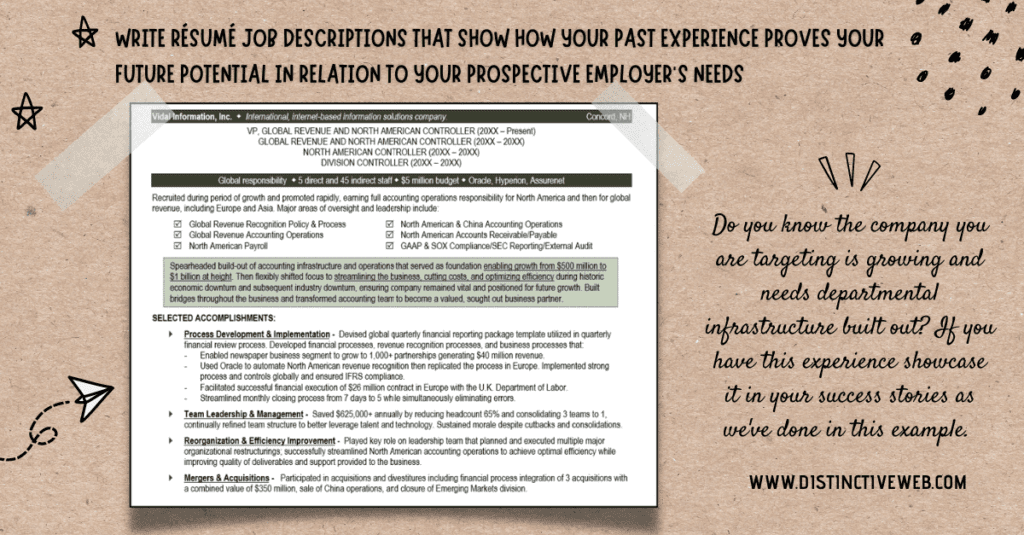
D: Do Your Homework
Beyond carefully reading each job posting, you should do your homework and learn as much as you can about your next potential employers. Knowing more about the company to which you plan to submit a job application will help you give even more dimension to your resume.
Familiarizing yourself with these details will help shape your job descriptions. In addition, this will aid you in making even more connections between your relevant professional experiences and the prospective employers’ needs.

E: Edit (Twice)
It cannot be stressed enough: a compelling resume job description won’t help you if a potential employer discovers an error. Spelling and punctuation errors will put your resume in the “do not call” pile faster than it can make it to the printer.
Some of the most common (and essential) mistakes to look for include:
Final Resume Job Description Considerations
To get the interview, creating a compelling, modern resume is a necessity for all job seekers.
Improving each job description in the professional experience section of your resume is an essential step in creating resumes that get attention and win interviews. To create compelling job descriptions that show your personality and professionalism remember to use verbs, connect the content, do your homework, and edit until you’re sure it’s perfect.
But if you feel at all overwhelmed, we are here for you! You do not have to struggle to create a perfect resume. Instead, let us write it for you! Book a free resume writing consultation today to learn more about our professional resume services. It is an investment in your career that will pay off many times over!
Frequently Asked Questions
What makes a resume compelling and stand out from the pack?
A compelling resume is one that tells a story about your accomplishments, not just your duties. It goes beyond listing basic job details, and it uses strong verbs to showcase actions and achievements. It also makes connections between your past experiences and the job you’re seeking.
What is the recommended structure for the professional experience section in a resume?
The professional experience section should be presented in reverse chronological order. It should include the company’s name, your job title, and the dates you held the position. Additionally, it should detail the job responsibilities and relevant skills you acquired during your tenure.
How can I make my job descriptions compelling?
The secret to compelling job descriptions is to turn them into stories of your accomplishments. Rather than just listing duties, focus on the challenges you faced, the actions you took, and the results you achieved. Using strong verbs instead of adjectives can help make your stories more impactful.
What is the C.A.R. approach in resume writing?
C.A.R. stands for Challenge, Action, and Result. It’s a technique for writing job descriptions on a resume. It involves outlining the challenge or situation you faced at work, the actions you took to tackle those challenges, and the results of your actions. This approach helps to tell a compelling story of your professional accomplishments.
How can I match my resume to the job posting?
You can make your resume match the job posting by including relevant keywords from the job ad in your resume. This can be important for passing through applicant tracking systems and for demonstrating to the hiring manager that your skills and experiences align with what they’re looking for in a candidate.
Why is researching about a potential employer important?
Researching about a potential employer helps you tailor your resume more effectively. It allows you to understand the company’s history, philosophy, target market, and competitors. This understanding can then be used to make more specific connections between your experiences and the employer’s needs.
Why is editing important in resume writing?
Editing is crucial to ensure your resume is free from spelling, punctuation, and grammatical errors. A single mistake can give the impression of carelessness and might prevent you from getting an interview. In addition, consistent formatting contributes to a professional appearance.
What if I'm overwhelmed by the resume writing process?
If you’re overwhelmed, you can seek professional help. There are services available that specialize in resume writing and can help present your experiences in a compelling and professional manner. These services can be an investment in your career and help you land the job you desire.
